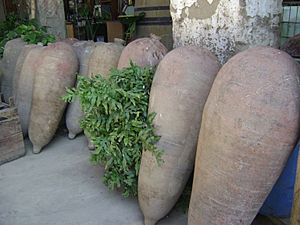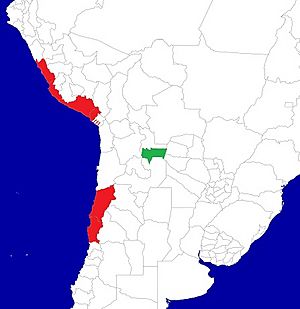Pisco facts for kids
Pisco is a clear or yellowish drink made from grapes in Peru and Chile. It's a type of fruit spirit, which means it's made by taking fermented grape juice and distilling it. This process turns the juice into a strong alcoholic drink.
Spanish settlers developed pisco in the 1500s. They needed an alternative to a similar drink called orujo, which was imported from Spain. Pisco was a great choice because it could be made from the many grapes grown locally.
Contents
What Does "Pisco" Mean?
The name "pisco" for this Peruvian drink was first used around 1764. It might have come from the Peruvian town of Pisco. This town was an important port for shipping grape products. It's located on the coast of Peru, by a river also called Pisco.
From this port, "Aguardiente de Pisco" (which means "Pisco spirit") was sent to Europe. Over time, people just started calling it "Pisco."
Some people think the word "pisco" comes from the Quechua language. In Quechua, "pisco" can mean "bird."
Another idea is that "pisco" was originally a word for a type of mud container. These containers were used to store the drink.
A Look Back: Pisco's History
How Pisco Started
Unlike many places in the Americas, some areas in Peru were perfect for growing grapes. By 1560, Peru was already making wine to sell. The wine industry grew so much that Spain felt it was a threat to their own wine sales.
In 1595, the Spanish King tried to stop new vineyards from being planted in the Americas. But people mostly ignored this rule. The King also tried to stop Peruvian wine from being shipped to other places like Panama and Guatemala.
Around the early 1600s, people started distilling wine into pisco. This might have been a way to get around the rules on wine. Until the early 1700s, much of this spirit was used to make wine stronger. This helped the wine last longer during long journeys.
Mining was a big deal in the 1600s, especially in Potosí. This city was huge and needed a lot of supplies, which helped boost the production of wine and pisco.
Why Peruvian Pisco Declined
The first grapes arrived in Peru in 1553. Pisco production began in the late 1500s. After the grapes were fermented and distilled, the drink was stored in clay jars called piscos.
In 1687, a big earthquake hit the southern coast of Peru. It destroyed cities like Pisco and Ica. Wine cellars collapsed, and the clay pots broke. This caused the grape-growing industry to suffer a lot.
In the early 1700s, Peru made more wine than pisco. But by 1764, pisco production was much larger, making up 90% of the grape drinks. Also, when the Jesuits (a religious group) left Spanish America, their vineyards were sold. The new owners often didn't have the same skills, which led to less production.
Later, in the 18th century, Spain allowed rum to be made in Peru. Rum was cheaper and not as good quality as pisco. In the 1800s, there was a high demand for cotton in Europe. Many Peruvian grape growers switched to planting cotton because it was more profitable. This also caused wine and pisco production to decline. This was especially true during the American Civil War (1861–1865), when cotton prices went way up.
Even with these changes, pisco was very popular in the US. People in San Francisco and other parts of California enjoyed it from the 1830s through the early to mid-1900s.
How Pisco is Made
Pisco is made from specific grapes like Muscat or Italia grapes. The process starts with fermenting these grapes.
First, the grapes go through "grape-stomping." This usually happens in the afternoon to avoid the hot sun. A group of people spread out in a winepress and stomp on the grapes. They often sing and joke while doing this!
The grape juice then flows into a special basin called a puntaya. The juice stays there for 24 hours. After that, it's moved to fermentation tubs. The fermentation process takes about 7 days. During this time, natural yeasts on the grape skins turn the sugar into alcohol. Pisco makers carefully control the temperature so it doesn't get too hot. This helps keep the natural smell and taste of the grapes, which is important for high-quality pisco.
Once fermentation is done, the pisco is distilled in large copper basins.
Caring for the Environment
Chile has been working to make pisco production clean and environmentally friendly. To reduce pollution and become more competitive, pisco producers and grape growers signed an agreement. This "Agreement of Clean Production" helps them work together. For example, one company, Capel, invested over 800 million Chilean pesos to improve its environmental practices.
Peru's pisco production is still done in a traditional way. This means they don't change the physical, chemical, or natural qualities of the pisco before bottling. It must be bottled right after it ages, without adding anything that could change its smell, taste, or look.
Who Can Use the Name "Pisco"?
There's a big debate between Peru and Chile about who has the right to use the name "pisco." Most historians believe pisco first came from Peru.
Peru says that only products from Peru can be called "pisco." However, they haven't convinced many other countries to agree with this.
Chile, on the other hand, thinks "pisco" is a general term. They argue it's just a type of alcoholic drink made from grapes, like how "whisky" or "vodka" are types of drinks. Chile allows two of its regions, Atacama and Coquimbo, to use the term "pisco."
Many large countries, like the European Union, the United States, and Canada, allow products from both Peru and Chile to be called "pisco." The European Commission believes pisco comes from Peru, but also lets Chile use the name for its products.
See also
 In Spanish: Pisco (aguardiente) para niños
In Spanish: Pisco (aguardiente) para niños
- List of piscos
- Singani
- Cocoroco



